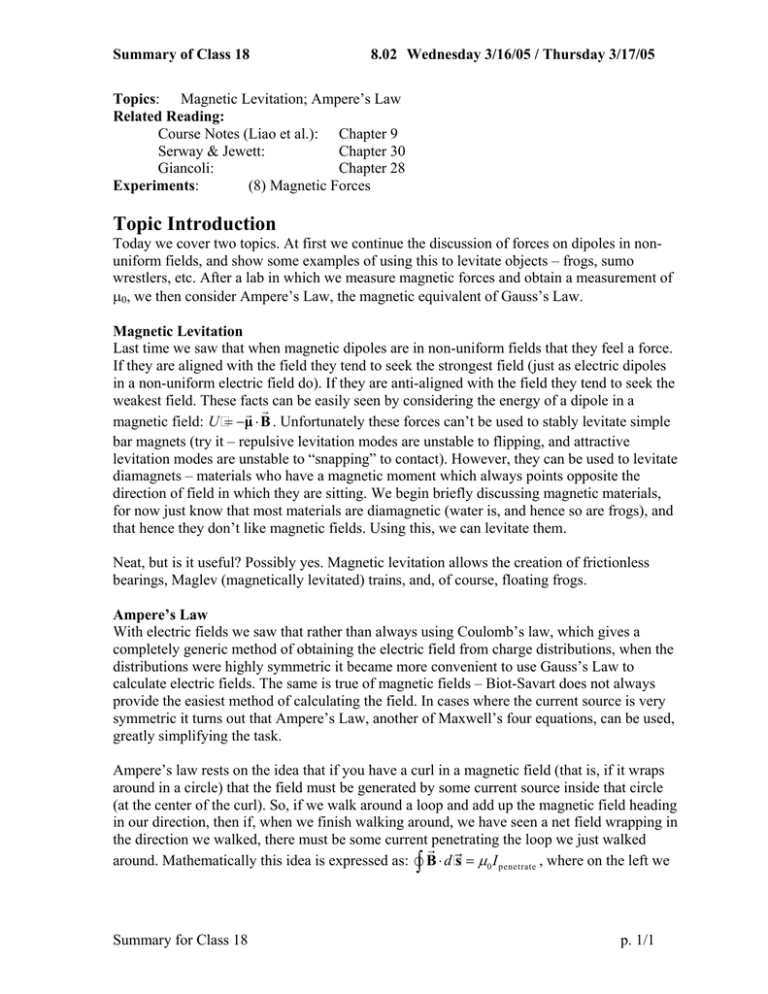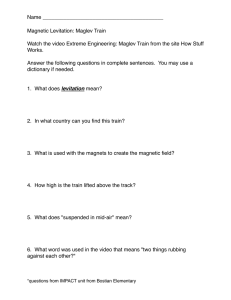Summary of Class 18 8.02 Wednesday 3/16/05 / Thursday 3/17/05 Topics
advertisement

Summary of Class 18 8.02 Wednesday 3/16/05 / Thursday 3/17/05 Topics: Magnetic Levitation; Ampere’s Law Related Reading: Course Notes (Liao et al.): Chapter 9 Serway & Jewett: Chapter 30 Giancoli: Chapter 28 Experiments: (8) Magnetic Forces Topic Introduction Today we cover two topics. At first we continue the discussion of forces on dipoles in nonuniform fields, and show some examples of using this to levitate objects – frogs, sumo wrestlers, etc. After a lab in which we measure magnetic forces and obtain a measurement of µ0, we then consider Ampere’s Law, the magnetic equivalent of Gauss’s Law. Magnetic Levitation Last time we saw that when magnetic dipoles are in non-uniform fields that they feel a force. If they are aligned with the field they tend to seek the strongest field (just as electric dipoles in a non-uniform electric field do). If they are anti-aligned with the field they tend to seek the weakest field. These facts can be easily seen by considering the energy of a dipole in a G G magnetic field: U = −µ ⋅ B . Unfortunately these forces can’t be used to stably levitate simple bar magnets (try it – repulsive levitation modes are unstable to flipping, and attractive levitation modes are unstable to “snapping” to contact). However, they can be used to levitate diamagnets – materials who have a magnetic moment which always points opposite the direction of field in which they are sitting. We begin briefly discussing magnetic materials, for now just know that most materials are diamagnetic (water is, and hence so are frogs), and that hence they don’t like magnetic fields. Using this, we can levitate them. Neat, but is it useful? Possibly yes. Magnetic levitation allows the creation of frictionless bearings, Maglev (magnetically levitated) trains, and, of course, floating frogs. Ampere’s Law With electric fields we saw that rather than always using Coulomb’s law, which gives a completely generic method of obtaining the electric field from charge distributions, when the distributions were highly symmetric it became more convenient to use Gauss’s Law to calculate electric fields. The same is true of magnetic fields – Biot-Savart does not always provide the easiest method of calculating the field. In cases where the current source is very symmetric it turns out that Ampere’s Law, another of Maxwell’s four equations, can be used, greatly simplifying the task. Ampere’s law rests on the idea that if you have a curl in a magnetic field (that is, if it wraps around in a circle) that the field must be generated by some current source inside that circle (at the center of the curl). So, if we walk around a loop and add up the magnetic field heading in our direction, then if, when we finish walking around, we have seen a net field wrapping in the direction we walked, there must be some current penetrating the loop we just walked G G around. Mathematically this idea is expressed as: v∫ B ⋅ d s = µ 0 I penetrate , where on the left we Summary for Class 18 p. 1/1 Summary of Class 18 8.02 Wednesday 3/16/05 / Thursday 3/17/05 are integrating the magnetic field as we walk around a closed loop, and on the right we add up the total amount of current penetrating the loop. In the example pictured here, a single long wire carries current out of the page. As we discussed in class, this generates a magnetic field looping counter-clockwise around it (blue lines). On the figure we draw two “Amperian Loops.” The first loop (yellow) has current I penetrating it. The second loop (red) has no current penetrating it. Note that as you walk around the yellow loop the magnetic field always points in roughly the G G same direction as the path: v B ∫ ⋅ d s ≠ 0 , whereas around the red loop sometimes the field points with you, sometimes G G against you: v∫ B ⋅ d s = 0 . We use Ampere’s law in a very similar way to how we used Gauss’s law. For highly symmetric current distributions, we know that the produced magnetic field is constant along certain paths. For example, in the picture above the magnetic field is constant around any blue circle. The integral then becomes simple multiplication along those paths G G B v∫ ⋅ d s = B ⋅ Path Length , allowing you to solve for B. For details and examples see the ( ) course notes. Important Equations G G Energy of Dipole in Magnetic Field: U = −µ ⋅ B G G B Ampere’s Law: v∫ ⋅ d s = µ0 I penetrate Experiment 8: Magnetic Forces Preparation: Read lab write-up. Today we will measure another fundamental constant, µ0. In SI units, µ0 is actually a defined constant, of value 4π x 10-7 T m/A. We will measure µ0 by measuring the force between two current loops, by balancing that force against the force of gravity. This is similar to our measurement of ε0 by balancing the electric force on a piece of foil between two capacitor plates against the force of gravity on it. The lab is straight-forward, but important for a couple of reasons: 1) it is amazing that in 20 minutes you can accurately measure one of the fundamental constants of nature and 2) it is important to understand how the currents in wires lead to forces between them. For example, to make the coils repel, should the currents in them be parallel or anti-parallel? Summary for Class 18 p. 2/2




